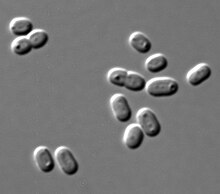| Synechococcus | |
|---|---|

| |
| Synechococcus PCC 7002 cells in DIC microscopy | |
| Scientific classification | |
| Domain: | Bacteria |
| Phylum: | Cyanobacteria |
| Class: | Cyanophyceae |
| Order: | Synechococcales |
| Family: | Synechococcaceae |
| Genus: | Synechococcus Nägeli, 1849 |
| Species | |
|
See text | |

Synechococcus (from the Greek synechos, in succession, and the Greek kokkos, granule) is a unicellular cyanobacterium that is very widespread in the marine environment. Its size varies from 0.8 to 1.5 μm. The photosynthetic coccoid cells are preferentially found in well–lit surface waters where it can be very abundant (generally 1,000 to 200,000 cells per ml). Many freshwater species of Synechococcus have also been described.
The genome of S. elongatus strain PCC7002 has a size of 3.4 Mbp, whereas the oceanic strain WH8102 has a genome of size 2.4 Mbp.[1][2][3][4]
- ^ Palenik, B.; Brahamsha, B.; Larimer, F.W.; Land, M.; Hauser, L.; Chain, P.; Lamerdin, J.; Regala, W.; Allen, E.E.; McCarren, J.; Paulsen, I.; Dufresne, A.; Partensky, F.; Webb, E.A.; Waterbury, J. (2003). "The genome of a motile marine Synechococcus". Nature. 424 (6952): 1037–42. Bibcode:2003Natur.424.1037P. doi:10.1038/nature01943. PMID 12917641.
- ^ Chen, X.; Widger, W.R. (1993). "Physical genome map of the unicellular cyanobacterium Synechococcus sp. strain PCC 7002". Journal of Bacteriology. 175 (16): 5106–16. doi:10.1128/jb.175.16.5106-5116.1993. PMC 204977. PMID 8349551.
- ^ "Synechococcus sp. PCC 7002, complete genome". 2013-12-11. CP000951.
- ^ "Picosynechococcus sp. PCC 7002 genome assembly ASM1948v1". NCBI. Retrieved 2024-06-09.